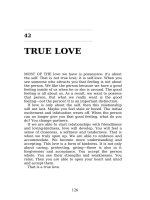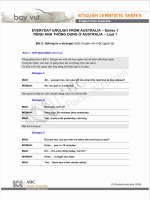Distinguishing Fact from Opinion
Bạn đang xem bản rút gọn của tài liệu. Xem và tải ngay bản đầy đủ của tài liệu tại đây (75.15 KB, 8 trang )
123
CHAPTER
12
D
ISTINGUISHING
F
ACT FROM
O
PINION
One of the most
important signs of a
good reader is the ability
to distinguish between
fact and opinion. This
chapter will show you
how facts are different
from opinions and how
this distinction can help
you remember more.
“J
ust the facts, ma’am, just the facts.”
This often-quoted line comes from the 1960s televi-
sion series “Dragnet.” On the show, Detective Joe
Friday and his partner would solve crimes by piecing together the facts
of each case. When Detective Friday told a witness that he was looking
for “just the facts,” he was making an important distinction between
fact and opinion. It didn’t matter to him who witnesses thought did it
or what witnesses thought happened. Rather, he needed to know what
really happened.
The key difference between fact and opinion lies in the difference
between believing and knowing. Opinions may be based on facts, but
READ BETTER
,
REMEMBER MORE
124
they are still what people think or believe, not what
they know. Opinions are debatable; facts are not. For
example, “Basketball is the most exciting sport” is
debatable; you might disagree. Thus, it’s an opinion.
But “Basketball is a team sport” is not debatable; it’s
impossible to disagree with this statement. It’s a fact;
it’s known for certain to be true.
You will understand and remember more if you
can distinguish between fact and opinion—between
what the writer thinks and what the writer knows,
between what is proven to be true and what needs to be proven. This is
largely because you can react to an idea once you identify it as either a fact
or an opinion. You’ll learn more about this in Chapter 13.
ASKING QUESTIONS
A good test for whether something is a fact or opinion is to ask yourself,
“Can this statement be debated? Is this known for certain to be true?” If
you can answer yes to the first question, you probably
have an opinion. If you can answer yes to the second,
you probably have a fact. For example, think back to
the topic sentences you created in Chapter 6. Were they
assertions that expressed fact, or opinion? Here’s one
topic sentence from that chapter:
The number of work-related accidents has dropped
by 50 percent.
Does this topic sentence express a fact or an opinion?
Well, is it debatable? Can someone disagree? Probably
not. It’s a matter of fact; something proven to be true by the specific
statistics provided in the rest of the paragraph.
Now look at this topic sentence:
Vanessa is a wonderful supervisor.
What are Facts?
• Facts are things known
for certain to have
happened.
• Facts are things known
for certain to be true.
• Facts are things known
for certain to exist.
What are Opinions?
• Opinions are things
believed or thought
to have happened.
• Opinions are things
believed or thought
to be true.
• Opinions are things
believed or thought
to exist.
DISTINGUISHING FACT FROM OPINION
125
Is this idea debatable? Definitely. Someone else might think she’s a lousy
supervisor, and someone else might think she’s just okay. This sentence is
clearly a matter of opinion.
P
RACTICE
1
Determine whether the following sentences are fact or opinion:
1
. America is a democratic country.
2
. America must preserve democracy at all costs.
3
. The meetings should be held on Tuesdays, not Wednesdays.
4
. These meetings are held Wednesdays.
5
. These meetings are often a waste of time.
Answers
1
.Fact
2
. Opinion
3
. Opinion
4
.Fact
5
. Opinion
WHEN FACTS AND OPINIONS
ARE MIXED TOGETHER
It’s usually easy to determine whether something is fact or opinion when
it’s standing alone like the sentences you just reviewed. It’s a little more
complicated when you’re working with paragraphs and larger texts.
That’s because unless what you’re reading is a textbook or a scientific or
technical manual, you’ll probably come across a combination of facts and
opinions, sometimes even in the same sentence. Here’s an example:
Email and other technologies make it possible for many
people to work from home, and companies should fully
support employees who want to “telecommute.”
The first part of the sentence expresses a fact; technology has indeed
made telecommuting possible for a lot of employees. But the second part
of the sentence—that companies should support the folks who want to
work from home—is clearly debatable. It is an opinion.
READ BETTER
,
REMEMBER MORE
126
P
RACTICE
2
Here’s a paragraph that has both fact and opinion. See if you can
correctly identify which ideas are debatable and which are not. Underline
the facts and use a highlighter or colored pen to highlight the opinions.
(Some things may be neither; just leave those sections as is.)
New York and other U.S. cities have begun using vehicles
powered by natural gas. This is a good idea, because vehicles
that use natural gas do not pollute the air. Pollution is the
biggest problem facing cities right now. Furthermore,
natural gas is more cost-effective than regular gas. All cities
should use only vehicles powered by natural gas.
Answer
N
ew Y
ork and other U
.S. cities have begun using vehicles
p
owe
red by nat
ural gas
. This is a good idea, because v
ehicles
that use natural gas do not pollute the air. Pollution is the
biggest problem facing cities right now. Furthermore,
natural gas is more cost-effective than regular gas. All cities
should use only vehicles powered by natural gas.
SUPPORT FOR OPINIONS
Because facts are things that are known to be true, readers generally don’t
need evidence that they’re true. Readers do want details, explanations, or
examples, but they often don’t need you to prove your case.
Opinions, on the other hand, are debatable, and they always need
evidence. Readers need to see why writers think and say what they do.
Often this evidence will come in the form of facts. But just because a
writer offers evidence for an opinion doesn’t mean readers have to agree
with that opinion. The same facts can often be used to support many
different opinions.
Still, an opinion that is supported by evidence (examples, details,
reasons, explanations, or statistics) is much stronger than opinions that
stand alone. For example, read the two paragraphs below. In one, the
writer supports her opinion, but in the other she does not.
DISTINGUISHING FACT FROM OPINION
127
Edward Wilson was an outstanding employee and a great
supervisor. He was a nice guy, too.
Edward Wilson was an outstanding employee. He came to us
as an entry-level production worker and worked so well with
others that he became a team leader within a year. He was
such an excellent team leader that the following year he was
promoted to supervisor. While he was a supervisor, his crew
consistently met or exceeded production goals and had the
fewest problems of any team with quality control. In addi-
tion, Edward was a very kind and generous person. He often
went out of his way to help the people he supervised. He
covered their shifts in emergencies, gave them rides home
when they worked overtime, and helped them resolve
conflicts with others.
Why is the second paragraph so much better than the first? Because
the second paragraph offers you more than just opinions. It offers opin-
ions supported by specific facts and examples. The first paragraph, on the
other hand, is just opinions. Every sentence is debatable. Every sentence
says what the author thinks is true, but not what is known to be true.
The author of the first paragraph doesn’t provide any evidence to
support why she thinks Edward Wilson was a great employee. As a result,
we’re not likely to take her opinion very seriously—certainly not as seri-
ously as we take the opinion of the writer of the second paragraph.
P
RACTICE
3
To strengthen your ability to distinguish between fact and opinion, try
this exercise. Take a fact, such as:
Many companies have dress down days on Fridays.
Then turn it into an opinion. Make a debatable statement about the
same subject, like the following:
1
. Dress down days improve employee morale.
2
. Every day should be a dress down day.









